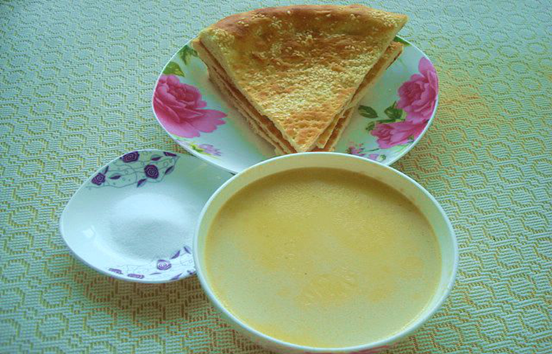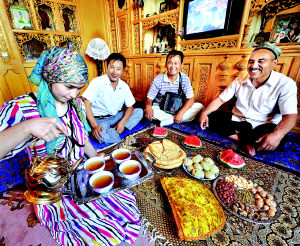The Xinjiang Uygur Autonomous Region, located in the northwestern border, is a multi-ethnic area dominated by Uighurs. The Uighur population accounts for about two-thirds of the region. In addition, there are Han, Kazakh, Mongolian, Hui, Kirgiz and other ethnic groups.
People who live here, love to drink tea, tea has become a necessity for the local people's life, and it is as important as eating. Therefore, they regard tea as "the fairy tea", and even the tea leaves that they have drunk is reluctant to discard. It is believed that feeding the horses with tea leaves can make the horses hair color brighter.
Northern Xinjiang is mainly drinking tea with milk. Southern Xinjiang is mainly composed of spiced tea, but no matter whether it is milk tea or spiced tea, it is made of tea brick.

The milk tea in northern Xinjiang is almost a must for the herdsmen to reach every household, and for many years. Usually in the middle of the herdsmen’s tents, an aluminum teapot is hung, and the bottom of the pot is placed on top of the coal stove that burns whole day long, so that the hot milk tea can be taken at any time. The method of making milk tea is not complicated. Generally, the tea brick is first broken into small pieces, and the teapot is full of water and cooked on a coal stove until it boils for 4-5 minutes. Putting a bowl of milk and the right amount of salt, and let it boil for about 5 minutes, a pot of hot, fragrant, salty milk tea is even made.

The spiced tea of southern Xinjiang is also made by brick tea. It is only the final ingredient, not milk and salt, but finely ground with spices such as pepper, cinnamon and etc,. The boiled tea is usually a copper long-necked teapot or an enamel teapot. To prevent the tea leaves and spices from mixing into the tea soup when pouring tea, a mesh filter is often placed on the spout.
People who live here, love to drink tea, tea has become a necessity for the local people's life, and it is as important as eating. Therefore, they regard tea as "the fairy tea", and even the tea leaves that they have drunk is reluctant to discard. It is believed that feeding the horses with tea leaves can make the horses hair color brighter.
Northern Xinjiang is mainly drinking tea with milk. Southern Xinjiang is mainly composed of spiced tea, but no matter whether it is milk tea or spiced tea, it is made of tea brick.

The milk tea in northern Xinjiang is almost a must for the herdsmen to reach every household, and for many years. Usually in the middle of the herdsmen’s tents, an aluminum teapot is hung, and the bottom of the pot is placed on top of the coal stove that burns whole day long, so that the hot milk tea can be taken at any time. The method of making milk tea is not complicated. Generally, the tea brick is first broken into small pieces, and the teapot is full of water and cooked on a coal stove until it boils for 4-5 minutes. Putting a bowl of milk and the right amount of salt, and let it boil for about 5 minutes, a pot of hot, fragrant, salty milk tea is even made.

The spiced tea of southern Xinjiang is also made by brick tea. It is only the final ingredient, not milk and salt, but finely ground with spices such as pepper, cinnamon and etc,. The boiled tea is usually a copper long-necked teapot or an enamel teapot. To prevent the tea leaves and spices from mixing into the tea soup when pouring tea, a mesh filter is often placed on the spout.